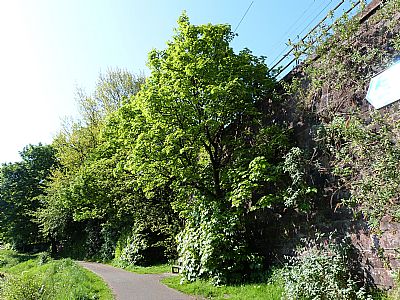SYCAMORE : Acer pseudoplatanus
This tree has distinctiive palmate leaves which measure 7cm to 16cm and have five lobes. (Palmate leaves have veins radiate in a fan shape from its stalk). Leaf stalks of younger trees are characteristically red. They occur widely around West Dunbartonshire.
Not to be confused with some of the maples. index.asp?pageid=734254
Also see Black Spots on sycamores index.asp?pageid=733646
In early May we see many of the leaves becoming shiny and sticky. This can last through the summer. The picture below was taken across the wall from Lomond Distillery. All the leaves were extremely sticky and quite shiny. Why?
So is this the Angel's Share? The Angel's Share by the way, is the evaporated % of whiskey that escapes from distilleries and most noticeable when it sticks to trees in the area making them black.
No. It is all because of aphids. The leaves often become sticky with secretion produced by aphids and a rain of this substance will fall in a sycamore wood covering everything below. This secretion is known as honeydew. A lovely name for something that is difficult to describe politely, but it is mainly sugary. This is discussed more here : SYCAMORE APHID
We are beginning to digress here, but the effect of Angel.s Share can be seen on trees in the vicinity and sometimes on ill-specified building fininshes such as porous facing brickwork. The wonderfully named Whiskipedia explains:
The Angels’ share is the romantic term for the annual rate of whisky lost during cask maturation due to evaporation. As the liquid would evaporate into the heavens, it was dubbed the angels’ share. From a scientific point of view, however, it is the volume of the liquid that turns into gas and then leaves the barrel.
The amount lost in Scotland amounts to only 1-2%, in contrast with considerably warmer climates such as India or Australia where evaporation can reach as high as 12%. Regardless even in Scotland that adds up quickly.

There are a number of both small and quite mature sycamores along the Leven towpath although some of these are squeezed against walls, such as the railway viaduct, or between other trees.

Sticky shiny leaves along the Leven towpath in June.
Sycamores are broadleaf trees that can grow to 35m and live for 400 years. The bark is dark pink-grey, and smooth when young, but becomes cracked and develops small plates with age.
The flowers are small, green-yellow and hang in spikes, or 'racemes'. After pollination by wind and insects, female flowers develop into distinctive winged fruits or seedpods known as samaras.
The Woodland Trust suggests that the Sycamore arrived in Britain with the Romans, but the Forestry and Land website may be more accurate noting that it was brought over from France in the Middle Ages. It was often planted to shelter and shade farm houses, as it can withstand salty winds.
One that grew in a gap between small hills alongside Hadrian's Wall in Northumberland became famous and popular not only for its iconic location and setting, but because it appeared in films such as Robin Hood the Prince of Thieves. The tree was felled in the early morning of 28 September 2023 in what Northhumberland described as "an act of vandalism". The felling of the tree led to an outpouring of anger and sadness. Two men from Cumbria, aged 38 and 31, were arrested in October 2023 and charged in April 2024 with criminal damage both to the tree and to the adjacent Hadrian's Wall. Their trial began on 28 April 2025 at Newcastle Crown Court and they were found guilty on 9 May. [Wiki]. The men had filmed themselves in the act on their phones. By mid-May there were signs of it sprouting new shoots. Time will tell if it really recovers at all, but it will never be the same again.
Many of our sycamores within West Dunbartonshire grow tall and proud, but may be obscured by other species. Some of those along the Leven towpath get hindered by the narrowness between the path and the walls or even get "trimmed" occasionally. Look out for them. They are still dignified trees contributing much to our natural environment.
Most deciduous UK trees go yellow in autumn before dropping their leaves. Those that turn red are generally introduced from the Americas. The sycamore is no exception and turns yellow. If you see a leaf like a sycamores, but it has gone from yellow to red, you are most likely confusing it with a maple.
Sycamore timber was popular for kitchen surfaces and utensils too, since it doesn’t stain or taint food and stays smooth, even after a good scrub. Its ability not to stain cloth meant it was also ideal for textile rollers. This last point is pertinent to the Vale of Leven. Perhaps the trees that we see here have decended from the textile industry that once thrived here.
FORESTRY AND LAND website of the Scottish Government : https://forestryandland.gov.scot/learn/trees/sycamore
WHISKIPEDIA : https://whiskipedia.com/fundamentals/angels-share/
WIKIPEDIA : https://en.wikipedia.org/wiki/Honeydew_(secretion)
https://en.wikipedia.org/wiki/Sycamore_Gap_tree
WOODLAND TRUST : https://www.woodlandtrust.org.uk/trees-woods-and-wildlife/british-trees/a-z-of-british-trees/sycamore/

